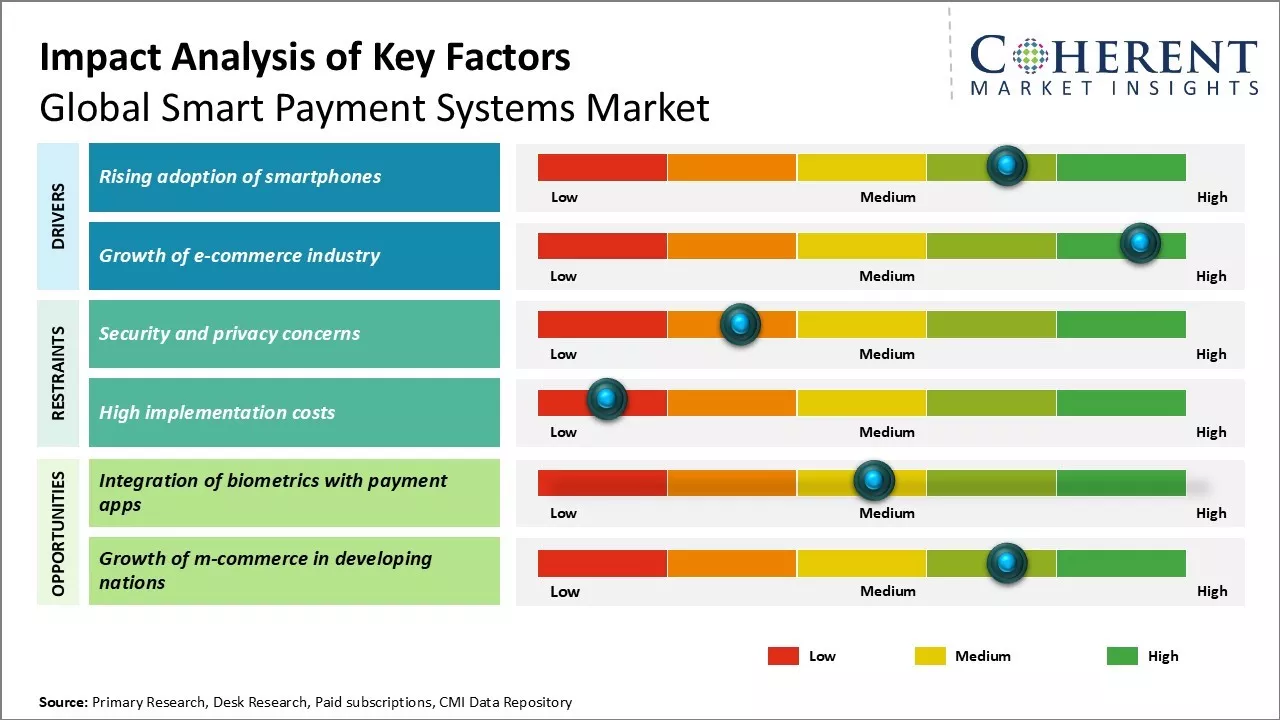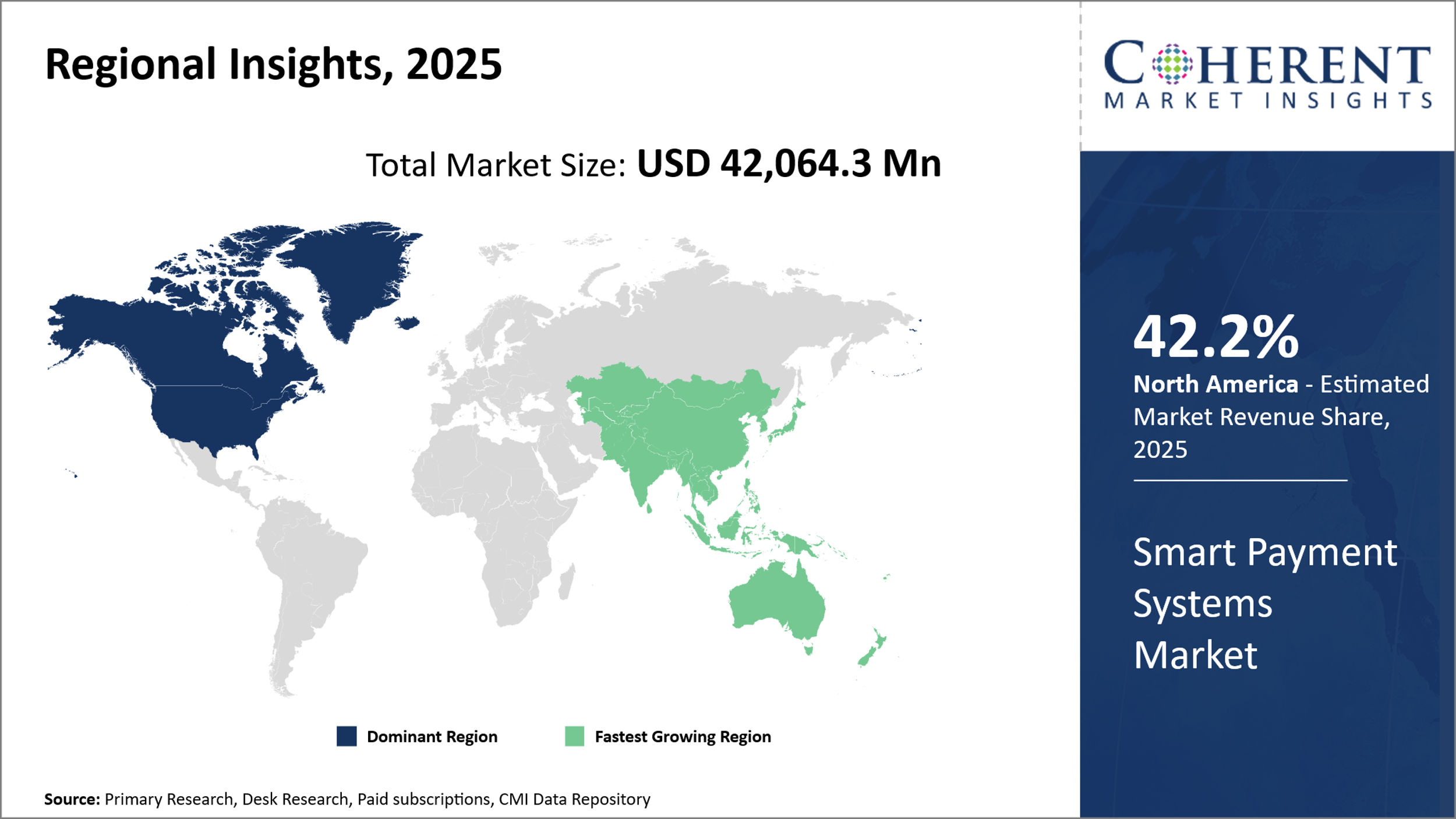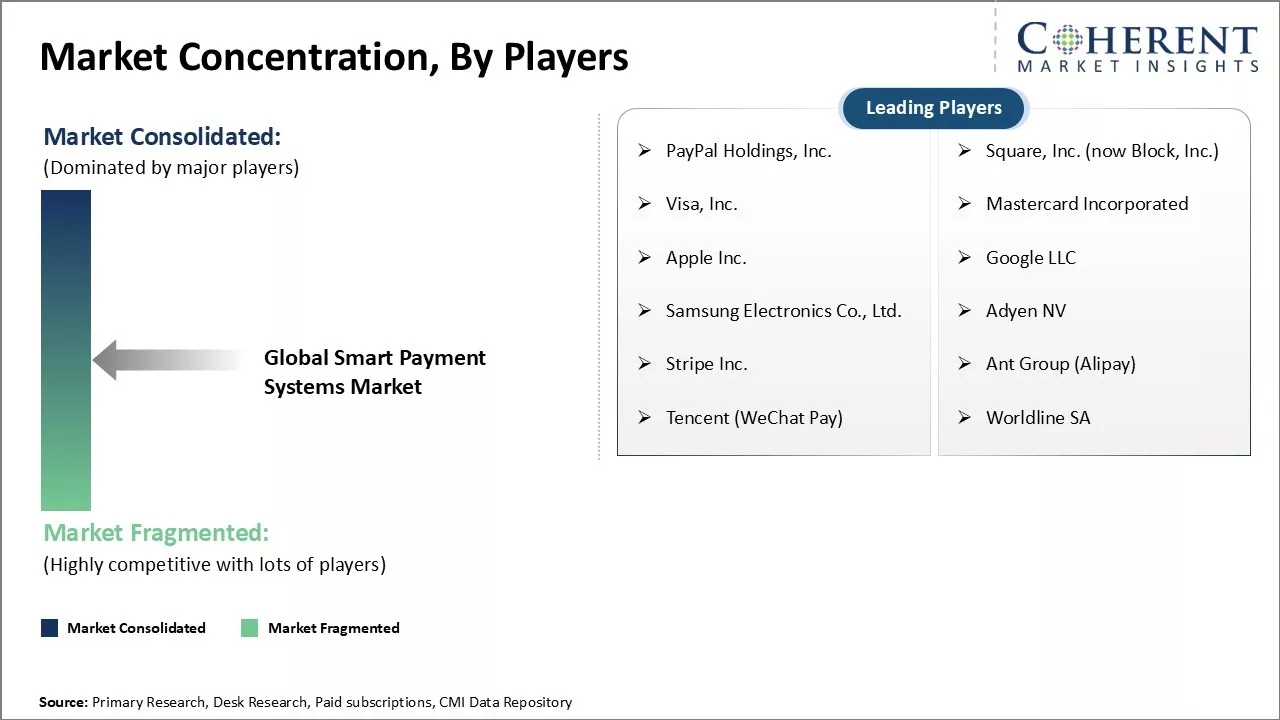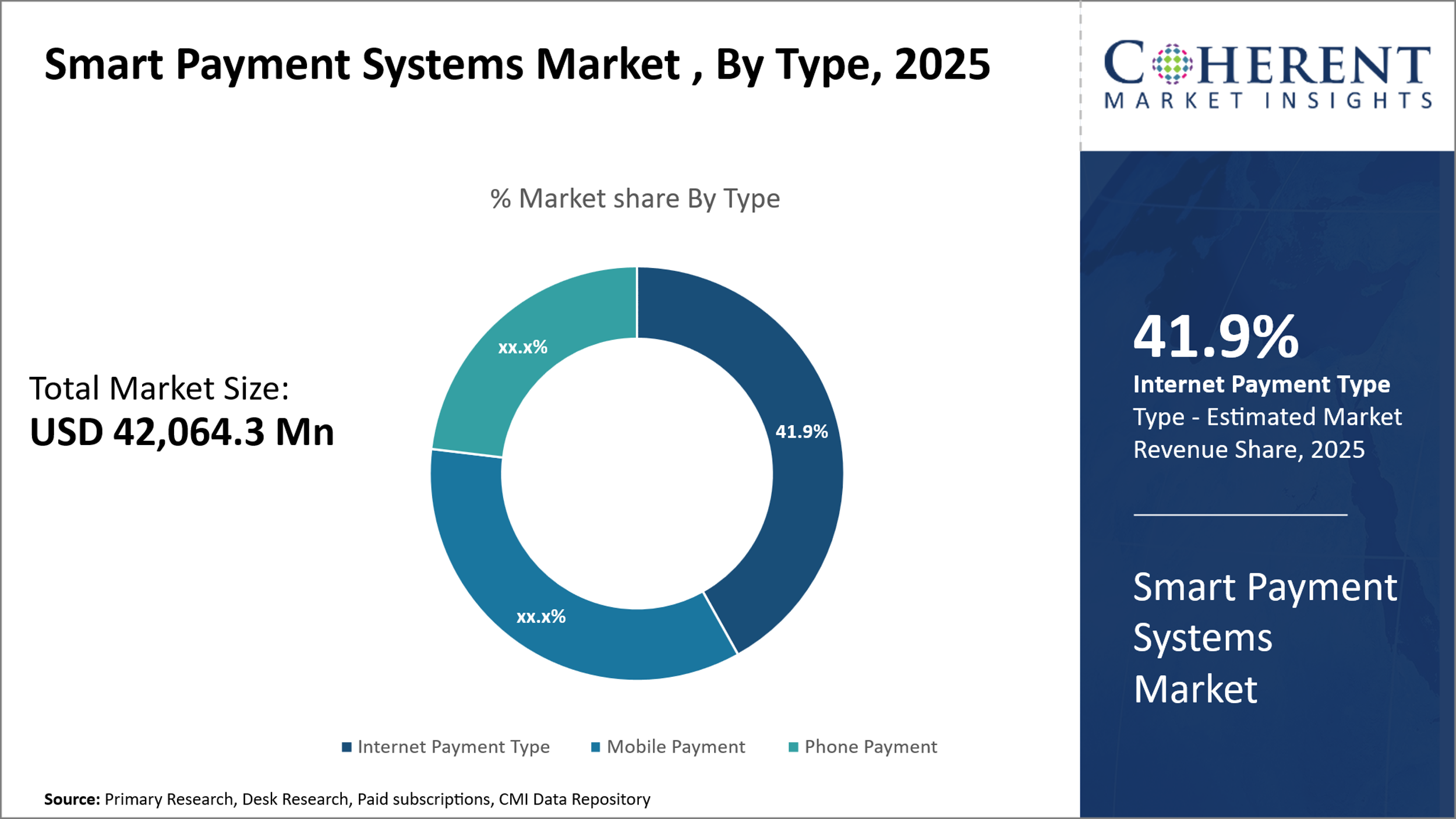Smart Payment Systems Market Size and Share Analysis – Growth Trends and Forecasts (2025-2032)
Global smart payment systems market is estimated to be valued at USD 42,064.3 Mn in 2025 and is expected to reach USD 94,807.4 Mn by 2032, exhibiting a compound annual growth rate (CAGR) of 12.3% from 2025 to 2032.

To learn more about this report, Download Free Sample
Key Takeaways
- On Basis of Type, the Internet Payments segment is estimated to hold the highest market share of 41.9% in 2025.
- On Basis End User, the Retail segment is estimated to hold the highest market share of 33.3% in 2025.
- North America is predicted to have the highest revenue share in the smart payment systems market, accounting for 42.2% in 2025.
Market Overview
The smart payment systems market has expanded rapidly as businesses and customers alike seek more efficient, safe, and smooth transaction solutions. Smart payment systems have become an essential component of modern commerce, owing to the advancements in mobile technology, digital wallets, contactless payments, and near-field communication (NFC) technologies. These solutions are critical for facilitating frictionless transactions, improving consumer experiences, and increasing security.
Current Events and Its Impact
|
Current Events |
Description and its impact |
|
Adoption of Biometric Authentication in Smart Payment System
|
|
|
Expansion of Cryptocurrency Payments in Retail |
|
Uncover macros and micros vetted on 75+ parameters: Get instant access to report
Role of AI (Artificial Intelligence) in Smart Payment Systems Market
AI plays a crucial role in enhancing smart payment systems by enabling faster, more secure, and personalized transactions. Through machine learning algorithms, AI can detect and prevent fraud in real time by analyzing spending patterns and identifying anomalies. It also improves user experience by automating payment processes, offering intelligent customer support, and enabling voice or facial recognition for authentication.
In September 2025, Google introduced the Agent Payments Protocol (AP2), a standardized system for AI applications to send and receive payments, including stablecoins. Developed with Coinbase, the Ethereum Foundation, and over 60 other partners, AP2 enables seamless transactions between AI agents and merchants.
Smart Payment Systems Market Insights, by Type
In the terms of type, the internet payments segment is estimated to hold the highest market share of 41.9% in 2025 owing to evolving consumer preferences and digital lifestyles. Younger consumers in particular have embraced online shopping and This demographic makes up an increasingly large portion of consumer spending as they enter their prime earning years. Their digital native upbringing and comfort with new technologies have weaned them off traditional payment methods like cash or checks in favor of seamless online checkout experiences.
Smart Payment Systems Market Insights, by End User
In the terms of end user, the retail segment is estimated to hold the highest market share of 33.3% in 2025. Physical retailers in particular have strong motivations to adopt next-generation mobile payment technologies. Enhancing the shopping experience is a key competitive differentiator as brick-and-mortar stores work to attract customers in an increasingly digital world.
Smart payment options, such as UPI, net banking, and others, allow retailers to streamline checkout for a quicker process while offering added convenience through options like pay by smartphone.
Regional Insights

To learn more about this report, Download Free Sample
North America Smart Payment Systems Market
North America is predicted to have the highest revenue share in the smart payment systems market, accounting for 42.2% in 2025. This dominance may be ascribed to strong financial infrastructure and broad consumer adoption of digital payment solutions.
Asia Pacific Smart Payment Systems Market
The Asia Pacific region is experiencing the fastest growth, headed by China, India, and South-east Asian nations. Rapid digitalization has driven market expansion in Asia Pacific.
Dominating Countries in Smart Payment System Market
United States Smart Payment System Market Analysis
The United States is still dominant in the market for smart payment systems, fuelled by the general use of digital wallets, mobile payments, and contactless technologies. These dominant players originated in the United States, including PayPal, Apple Pay, and Square, so the United States dominates. The financial infrastructure is strong in the country, there is a technology-conscious population, and there is high consumer demand for easy, secure payment technologies to make it a hotbed for smart payment innovations.
China Smart Payment System Market Analysis
China is a prominent contributor to the global smart payment systems market, with the likes of Alipay and WeChat Pay transforming the payment-making process among consumers. With high smartphone penetration and the development of a cashless economy, China's aggressive take up of mobile payments has placed the country in a position to dominate mobile and QR code-based payment solutions. The support from the Chinese government to digital payment infrastructure has also contributed to the growth of the market.
India Smart Payment System Market Analysis
India is experiencing a steep growth in the adoption of smart payments, led by government drives like Digital India and efforts towards becoming a cashless economy. Mobile wallets such as Paytm, PhonePe, and Google Pay are greatly adopted in both urban and rural areas. The nation's vast population of unbanked individuals is also propelling the need for convenient digital payment options, leading India to become one of the most rapidly expanding markets in the smart payment systems industry.
Market Concentration and Competitive Landscape

To learn more about this report, Download Free Sample
Market Report Scope
Smart Payment Systems Market Report Coverage
| Report Coverage | Details | ||
|---|---|---|---|
| Base Year: | 2024 | Market Size in 2025: | USD 42,064.3 Mn |
| Historical Data for: | 2020 To 2024 | Forecast Period: | 2025 To 2032 |
| Forecast Period 2025 to 2032 CAGR: | 12.3% | 2032 Value Projection: | USD 94,807.4 Mn |
| Geographies covered: |
|
||
| Segments covered: |
|
||
| Companies covered: |
PayPal Holdings, Inc., Square, Inc. (now Block, Inc.), Visa, Inc., Mastercard Incorporated, Apple Inc., Google LLC, Samsung Electronics Co., Ltd., Adyen NV, Stripe Inc., Ant Group (Alipay), Tencent (WeChat Pay), and Worldline SA |
||
| Growth Drivers: |
|
||
| Restraints & Challenges: |
|
||
Uncover macros and micros vetted on 75+ parameters: Get instant access to report
Market Dynamics
Smart Payment Systems Market Driver
Increasing use of smartphones
Evolving features and need for connectivity has brought smartphones into every nook and corner of our lives. To illustrate, with statistics from the United Nations, the world witnessed a tremendous 6 billion smartphone subscriptions itself, accounting for a whopping 75% penetration rate across the globe.
With increasing ownership of smartphones spreading across regions, particularly in the emerging markets, more users are increasingly opting to use their device's payment facility instead of physical cards or even cash. Payment apps such as Google Pay, Apple Pay, Samsung Pay, and a few others have leveraged this to offer a convenient payment experience for users.
Google Pay had become one of the leading mobile payment apps in the country, with over 150 million monthly active users. This surge in adoption is largely driven by the widespread use of smartphones, particularly in emerging markets, and the increasing preference for digital payments over traditional methods like cash.
Smart Payment Systems Market Opportunity
One of the key opportunities for the global smart payment systems market is the merging of biometrics and payment apps. Efforts by the government to introduce digital payments and related security technologies are also promoting growth.
Smart Payment Systems Industry News
- In February 2024, Nuvei, a Canada-based FinTech company, developed an improved Omni-channel payment solution for merchants and platforms. For the first time, the unified commerce offering will be available to customers outside of North America, allowing businesses to build new customer payments experiences with more control and united analytics.
- In September 2024, the European Payments Initiative (EPI) launched Wero, a unified digital payment wallet aimed at replacing existing national systems like Giropay in Germany, Paylib in France, and iDEAL in the Netherlands.
Key Takeaways from Analyst
- Global smart payment systems market is poised to grow significantly with the increasing demand for contactless and mobile payments globally. The ease and convenience of smart payment methods for consumers as well as merchants have enhanced their usage. Additionally, enhanced smartphone and mobile internet penetration would make more customers adopt digital payment solutions.
- North America is expected to lead the smart payment systems market throughout the forecast period. The region has the world's largest payment technology vendors and is experiencing growing acceptance of digital modes of payment among its vast population. Additionally, encouraging government programs to encourage cashless payments in nations such as India and China present opportunities for vendors.
- But data security and privacy issues may slow the market's growth to some degree. People are apprehensive of cyber-attacks in the form of data leakage while making financial transactions on digital platforms. Exorbitant investment needed to replace current infrastructure is another problem, particularly in emerging economies. Interoperability problems because of a lack of commonly accepted standards may also limit the full potential of smart payment systems.
Market Segmentation
- By Type Insights (Revenue, USD, 2020 - 2032)
- Internet Payment
- Mobile Payment
- Phone Payment
- By End-use Industry Insights (Revenue, USD, 2020 - 2032)
- Retail
- BFSI (Banking, Financial Services, and Insurance)
- Healthcare
- Transportation
- Entertainment & Media
- Other
- By Regional Insights (Revenue, USD, 2020 - 2032)
- North America
- U.S.
- Canada
- Latin America
- Brazil
- Argentina
- Mexico
- Rest of Latin America
- Europe
- Germany
- U.K.
- Spain
- France
- Italy
- Russia
- Rest of Europe
- Asia Pacific
- China
- India
- Japan
- Australia
- South Korea
- ASEAN
- Rest of Asia Pacific
- Middle East
- GCC Countries
- Israel
- Rest of Middle East
- Africa
- South Africa
- North Africa
- Central Africa
- Key Players Insights
- PayPal Holdings, Inc.
- Square, Inc. (now Block, Inc.)
- Visa, Inc.
- Mastercard Incorporated
- Apple Inc.
- Google LLC
- Samsung Electronics Co., Ltd.
- Adyen NV
- Stripe Inc.
- Ant Group (Alipay)
- Tencent (WeChat Pay)
- Worldline SA
Sources
Primary Research Interviews
- Apple Inc.
- Amazon.com Inc.
- NMI (Network Merchants Inc.)
- FIS (Fidelity National Information Services)
- Others
Databases
- Research and Markets
- IBISWorld
- Others
Magazines
- PYMNTS.com
- Fintech Futures
- Retail Payments Hub
- Others
Journals
- Journal of Payments Strategy & Systems
- International Journal of Financial Studies
- Others
Newspapers
- Financial Times
- The Wall Street Journal
- Bloomberg Businessweek
- Others
Associations
- Electronic Transactions Association (ETA)
- Smart Card Alliance
- Global Digital Finance (GDF)
- Others
Public Domain Sources
- Federal Reserve Payments Study
- World Bank Global Findex Report
- National Retail Federation (NRF)
- Others
Proprietary Elements
- CMI Data Analytics Tool
- Proprietary CMI Existing Repository of information for last 8 years
Share
Share
About Author
As an accomplished Senior Consultant with 7+ years of experience, Pooja Tayade has a proven track record in devising and implementing data and strategy consulting across various industries. She specializes in market research, competitive analysis, primary insights, and market estimation. She excels in strategic advisory, delivering data-driven insights to help clients navigate market complexities, optimize entry strategies, and achieve sustainable growth.
Missing comfort of reading report in your local language? Find your preferred language :
Transform your Strategy with Exclusive Trending Reports :
Frequently Asked Questions
EXISTING CLIENTELE
Joining thousands of companies around the world committed to making the Excellent Business Solutions.
View All Our Clients

